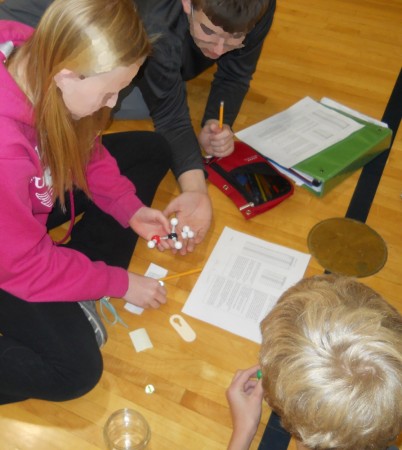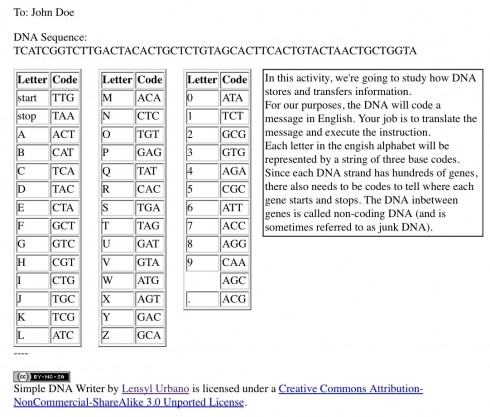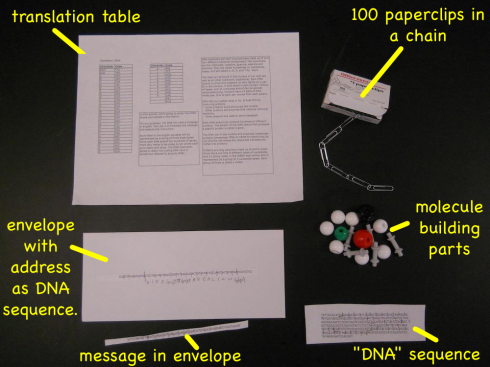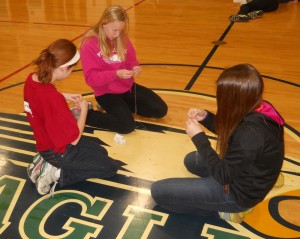
Fascinating street art (by Nomerz) aimed at reclaiming abandoned spaces.
Middle and High School … from a Montessori Point of View

Fascinating street art (by Nomerz) aimed at reclaiming abandoned spaces.
I’ve previously posted an animated illustration of the slope-intercept form, and you can use the straight lines (linear equations) app to check if you’re drawing straight lines correctly.
Carl Segan’s Cosmos series contains a wonderful overview of the history of life.
The one possible criticism of the video is that evolution could be misconstrued as a gradual, linear process (although Segan is pretty clear that this is not the case). BouncingDodecahedrons has an interesting image showing the splitting and coiling of the process.
I prefer to illustrate evolution using the tree of life.

Street Art Utopia is a wonderful site that collects amazing photos of street art from around the world.

“It is only by measuring we can cross the river of myths.” — Hans Rosling
Hans Rosling explains, in wonderfully graphical form, how as child mortality has improved so has quality of life, which has in turn lead to fewer births and population stabilization.
More details on the general reduction in poverty in The Guardian.
“We want to put chemicals on it and see what happens,” she said.
I was not quite sure how to respond. First of all, I didn’t know what “it” was. Secondly, I had no idea about what chemicals the three of them wanted to “put on it”. And thirdly, I was wondering why they even thought that students could just wander into the chemistry lab and get my permission to “put chemicals” on some random stuff, just to see what would happen.
For the last question, alas, I’m afraid to say that they may, perhaps, know me too well. However, given my visceral antipathy to inexact language — especially in a science lab where safety is always a concern — based on the first two questions, they don’t know me quite well enough.
An interrogation ensued.
“It” turned out to be two sad-looking pieces of dried apple. They weren’t dried when they’d been left in someone’s locker who knows how long ago, but they were pretty dessicated now.
The “chemicals”, on the other hand, they weren’t quite so sure about. Or at least they didn’t want to tell me right away. They may have had different ideas about what they wanted to see.
“We want to see it burn and smoke!” explained the second one happily. I didn’t have to express either skepticism or approbation verbally, my face responded automatically.
“We just want to see bubbles and stuff,” suggested the first one somewhat tentatively; eying my facial expression carefully.
The third one said nothing, but she tends to reticence. I looked at her inquiringly to give me a second to think.
That’s when I realized that they were all in chemistry together. They’ve been working with chemicals, studying different types of reactions for the last eight months, so they probably had at least some idea about what they were asking about.
The Montessori axiom is to follow the child, and here they were expressing an interest in chemistry. It was an ill-formed interest perhaps, but an interest non-the-less, so maybe there was something I could work with.
I needed a way to gauge just how serious they were about their project, and, at the same time, tie it back to what they’d been learning in class. Were they interested enough to puts some serious thought into it?
So I told them that, if they could tell me exactly what chemicals they wanted to use, and write the chemical equations to show what would happen, I’d let them do it.
They were on it.
The first thing was to figure out what was in the apples that could react. Well, the apples had come pre-sliced, and fresh in one of those small, clear, plastic bags. The first student, who was taking charge of the group, ducked out of the room to retrieve it from the garbage can across the hall.
I’d expected that the ingredient list to be very sparse. Ideally just the single word, “apples”, with maybe the type of apple listed if the packet labelers were feeling verbose. However, it turns out that those “fresh” slices needed something to keep them looking good and tasty. So these fresh apple slices appear to contain some amount of calcium carbonate. That was a chemical they knew.
Their first thought was a single replacement reaction. If they added potassium to it then the potassium would replace the calcium and they’d see something interesting. It took a few minutes, and a little nudging of the quiet one to help out with the charges, but eventually they wrote out and balanced the reaction:
2 K + CaCO3 –> K2CO3 + Ca
The problem is, I pointed out, there’s nothing in that reaction that would produce bubbles. I didn’t even want to bring up heat and the exothermic and endothermic reactions, nor the fact that potassium is a solid, as is the calcium carbonate, which would make getting them to react dramatically a little bit difficult. I didn’t even point out what would happen if the potassium came in contact with water (or even sodium), because I know Ms. Wilson is planning on doing that little demonstration in the near future.
So what reactions produce bubbles? This took some further thought. With a few dropped hints, they came up with acid-base reactions, particularly, the reaction between calcium carbonate and hydrochloric acid. I pretty much told them what the products would be, and, with a little more coaxing of the quiet one for help, they were able to balance the reaction.
CaCO3 + 2HCl–> CaCl2 + CO2 + H2O
Now they were finally good to go. Unfortunately, it was also time to go P.E.. And they’d managed to drop one of the apple pieces into a bucket of water that my calculus students had left lying around after their bottle draining experiment.
So I told them they could try it tomorrow. Unfortunately, tomorrow is the field trip, so they’ll have to do it the day after.
We’ll see how it goes.

This simulation was designed to have middle school students practice reading instructions (proteins) from a sequence of genetic bases (DNA) to better understand how gene translation works and learn the types of things that proteins do. The exercise and discussion lasted 55 minutes (with one preparatory homework assignment). Students appeared to have a lot of fun doing the simulation (especially because of the competition between groups) and we had an excellent discussion afterwards.
DNA holds the instructions that control what our bodies in the pattern of molecules (nucleobases) that make up our genes. The genes are located in the nucleus of our cells (as well as for all eukaryotes). When genes are expressed, they create proteins that actually get all the work done.
The jobs of proteins can be summed up a three things:
Using the DNA Writer application for converting text into simulated DNA sequences, I create an exercise for students to practice:
The simulation was modeled as a competitive game, with the class of 7th and 8th graders broken into four groups that competed against one another to see who could complete the instructions the fastest. I cheated, I’m afraid, because what I did not tell them was that, in order to complete the last instruction, the groups would all need to work together, so there would be no single group winner.
Example Homework Assignment: HW-eg.pdf
This being the first time I’ve tried anything like this, I was not sure how long it would take students to translate the DNA code to english, so a couple days before the simulation I handed out individualized homework assignments so they could practice. I chose science vocabulary words like “protein”, “ribosome”, and “amino acids” for short, simple messages.

At least I had intended for it to be homework. As soon as they got the handout, and the 2 minute explanation about how it worked, they hashed out the messages in about five minutes.
The trickiest part was that the first few letters they translated did not make any sense, since they’re random sequences meant to represent non-coding DNA. However, once they got to the “start” codon it was pretty easy sailing.
Given how fast they were able to do the translation (and how eager and enthusiastic they were about it), I realized how unfounded were my fears that the translations would take too long for the competitive part of the exercise to work.
There are only a few materials required for this lab:

For each group
TATTGCACATTGGAGGATATCATCAGCACTGAGACTCACT
AGAGCACTATCATCAGCTAGCGTCTAAGCGAGACTGAGCT
ACACTCAATCCTGGAGTGATAACTCTCACTAGTATAGTCG
TTGCATGATCTGATCTACAGCACTAGCACACTATAGCGTA
CTCTCCTAAGCACATGTATCCTATCAGATATCCTATAATG
TCTATGCGTATCATTGCATGATCTGATCTACAGCACTAGC
CATGATTAGACTCTCCTAAGCACATGTATCCTATCAGATA
TCCTATAAGCAATCCACGCT

So I took the class to the gym and stuck each of the four groups on a side of the basket ball court. Each group had a jar of molecule parts (only enough to build a methane molecule), an addressed letter with a message in it, and the long DNA sequence.
The paperclips were in a box in the center circle of the court.
We gathered around the center circle for instructions, which basically consisted of me telling them they had to
They were eager to go.

The entire thing went remarkably smoothly, which was somewhat surprising since this is the first time I’ve ever tried anything like this.
It only took 20 minutes from the time they started to when they finally put together the butane molecule.
A few small issues did come up, however.
Since they had only ever decoded a single instruction from a single DNA sequence before, almost all the groups stopped after the first instruction on the long sequence (pull apart the paperclips). I had to point out that a real DNA sequence contains a whole sequence of genes, so they probably ought to continue translating.
Another group tried doing shortcuts, and when they saw that they had parts from the molecule building kit and the instruction was, “BUILD A M”, they assumed that they were just supposed to build any molecule. I had to intervene on that one too.

When the person from the third group arrived to help pull apart the paperclips, the two already there complained that more people would just slow them down. I had to point out that they could just break the long chain they were working on into smaller pieces and then everyone could work and the work would go a lot faster. The breaking of the chains is supposed to represent the catalytic effect of enzymes.
One group mistakenly blocked off the first two letters in the DNA sequence instead of the first three (for a codon), and couldn’t figure out why their sequence was not telling them anything. I had to help out with that one, but in our post-simulation discussion it reminded me to talk about transcription errors and how the genetic code can change.
Finally, they were, some more than other, sorely disappointed that there would be no winner. They so wanted to win that they did not want to share their molecule parts to build the butane molecule.

When we were done with the exercise, we gathered around in the center circle to debrief. We reviewed what DNA does and the three things that proteins do:
I actually forgot to talk about the transcription errors one group was making during our circle discussion, so we ended up talking about it on the following day. One student had remembered the video I showed earlier about gene expression that compared the rate of errors in DNA encoding compared to computer disks. The DNA coding is much more reliable, but when billions upon billions of bases are being coded then errors will still creep in.
This lead to a discussion about mutations, and how some DNA transcription errors could give messages that made no sense and would be ignored, while others could send signals that could affect the body’s functions. The latter types of mutation can be good or bad.
The exercise went remarkably well. Key to it, I think, was the fact that the students were able to so efficiently translate the DNA code to English. Also, the instructions were designed to feed back into things they’d done in the past, like assemble covalent molecules and polymers.
Monthly climatic data from the Eads Bridge, from 1893 to the 1960’s. It’s a comma separated file (.csv) that can be imported into pretty much any spreadsheet program.
The last three columns are mean (MMNT), minimum (MNMT), and maximum (MXMT) monthly temperature data, which are good candidates for analysis by pre-calculus students who are studying sinusoidal functions. For an extra challenge, students can also try analyzing the total monthly precipitation patterns (TPCP). The precipitation pattern is not nearly as nice a sinusoidal function as the temperature.
Students should try to deconstruct the curve into component functions to see the annual cycles and any longer term patterns. This type of work would also be a precursor the the mathematics of Fourier analysis.
This data comes from the National Climatic Data Center (NCDC) website.